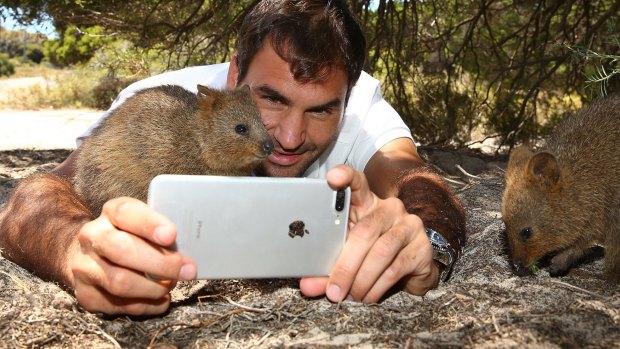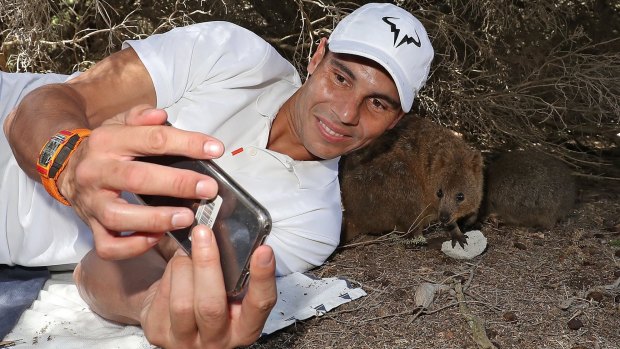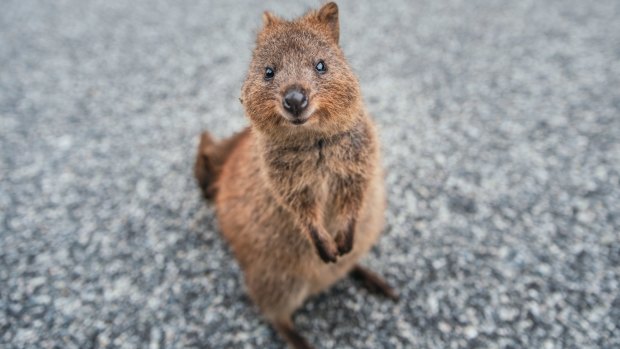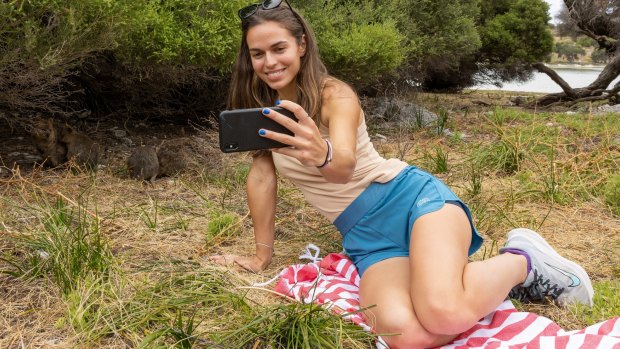This was published 1 year ago
Rottnest Island quokkas: The big problem with selfies with 'the world's happiest animal'

Roger Federer's quokka selfie in 2018 became a viral hit.Credit: Getty Images
Roger Federer became one of the most renowned and cashed-up sportsmen in history by dispatching fuzzy little balls with elegant and accurate strokes, but one of his most celebrated shots needs to be called out, loudly and clearly.
It wasn't one of his trademark one-handed backhands, punishing a lifeless Slazenger into an undefended corner of Wimbledon's perennial ryegrass. No, this time Roger ditched his tennis racquet for an iPhone and laid down on the unfamiliar sandy surface of Wadjemup/Rottnest Island. And the fuzzy little ball in question was a quokka.
Federer didn't pioneer the 'quokka selfie' but this 2017 stage-managed pre-Australian-Open publicity grab 'blew up' on social media, rapidly making it okay in the court of public opinion to crouch down close to these lovable little wild sand teddy bears (not actual scientific name). Sensing a bankable trend, circling marketeers and PR folk invited tourism ambassadors like Kylie and at least one Hemsworth to have a shot. Even 'Rafa' volleyed a few years later, although his selfie game was reportedly atrocious.

Rafael Nadal also got in on the act in 2020.Credit: Getty Images
Naturally, a digital conga-line of unquestioning, compliant semi-professional attention-seekers joined in. Fremantle accommodation providers reported that Instagrammers were pit-stopping overnight with the express purpose of catching the early-morning ferry to 'Rotto', snapping a quick shot, then jumping on the next available mainland-bound vessel. And, so, the quokka selfie passively plopped into Western Australia-bound travellers' bucket lists.
So, what's the problem, you wretched, joyless, glee-griding fun-slayer? Well, after my virgin visit to Rottnest, I have two. But first, let's take a brief snapshot of these marvellous marsupial macropod mammals for which this island off Perth is mis-named (Dutch explorer Willem de Vlamingh thought they were rats).
On a basically predator-less paradise, the quokka is overall in pretty rude health, according to Rottnest volunteer guide Bill Brennan-Jones, who leads 'Meet the Quokkas' walking tours. There's an estimated 10-12,000 of them in any given season, depending on factors like the previous mating season's weather. Quokkas generally breed once a year, typically producing one Joey, commonly born around February and March and emerging from pouches around September ('Quokka Birthday' month).

Quokkas' natural facial expression giving the impression of a smile has seen them dubbed 'the happiest animals on Earth'.Credit: Damian Lugowski
Quokkas have been on Rottnest "forever", outliving larger mammals that died out after the island became isolated from the rest of Australia about 7000 years ago. They once abounded on the mainland, but predators have since dined out on all but a small community of the timid critters (in south-west WA).
I saw not a solitary quokka on my (highly recommended) three-hour morning bicycle circumnavigation of Rottnest's stunning, windswept extremities. My 'ick', as the youngsters say, began when I sat down for lunch at The Settlement, homebase to Rottnest's ferry terminal, visitor centre and, significantly, a cluster of restaurants.
It started sweetly enough. A cherubic quokka sidled up to my stinky sneakers a minute after I planted my keister on a shady picnic bench. Seconds later, he/she took our relationship to the next level, hopping up onto the seat and gently resting a tiny paw on my sweaty thigh. Awww, isn't that heart-warming, I thought, until 'the happiest animal in the world' lunged clumsily over my lap at my succulent sausage roll.

Valentini Grammatikopoulou gets her selfie at a distance.Credit: Paul Kane
Ninja-like, I thwarted this heist, but in the time it took me to stuff my saucy sausage roll into my pie hole, I witnessed two successful food-snatching incidents nearby – one which caused a family to hilariously scream in chorus. I also saw three people slyly dropping food onto the ground for awaiting quokkas. I watched the fuzz balls infiltrate the fenced-off bakery patio, sneaking in behind as people opened the gate to the clearly signed no-quokka zone. The infiltrators vacuumed up under-table pastry crumbs like noiseless mammalian Dustbusters.
All around, people leaned, squatted and laid down next to quokkas with the sensitivity of princess-chasing paparazzi, often accidentally touching the animals (as indeed Roger seems to have done). In short, a notable number of humans have forgotten, don't know or don't care that these are wild animals, afforded protection under Rottnest's status as an A Class Reserve.
"The policy is no feeding and no touching, mainly because they are a wild animal and the whole purpose is to maintain their natural environment," says Bill Brennan-Jones. "You can take selfies, but certainly not by picking one up. The idea is that you interact with them in their environment. If you lie down near one, they are naturally curious and will come and see you."
Rangers can fine people for touching or feeding quokkas, but Bill prefers to discourage people beforehand. "If I see kids trying touch them, I'll tell them not to and explain why." A pragmatic and tolerant approach for humans but does it go far enough for the quokka itself, given mounting evidence of the effect of human intervention on animals drawn to the Settlement?
"There are thousands of quokkas but you won't see [most of] them during the day because they are nocturnal. They come [to the Settlement] in the day, of course, because people feed them. Sometimes you'll see quokkas with big tuffs of fur out of them and sometimes that's because the diet is not good for them. It can be very upsetting for the way their body works."
"Rottnest has 12 lakes but they're salt lakes so quokkas are used to getting water not by drinking it but by eating leaves and succulents. So even giving them a big drink of water is not good for them."
A common refrain from quokka-selfie advocates is that the animal likes the interaction because they 'smile'; in the same way I grinned when I stuffed the aforementioned sausage roll down my gullet or reluctantly bare my gnashers for a group selfie.
Using this primary-school logic, the quokkas' expression could also be interpreted as an awkward grin – triggered by an animal 25 times your weight getting 'up in your grill' – or the relieved face of a macropod expelling a bowel full of gas after a sugar and fat binge. Science deflates the optimistic anthropomorphism further, theorising that the animal's open mouth is at least partly a heat-regulating mechanism (similar to a dog panting).
Quokkas aren't at the bag-snatching stage of South-East Asian primates but they've been known to mistake human fingers for food when being illicitly fed so the time for action is nigh. I'm not suggesting exclusion zones or mass quokka relocation, just two simple steps. Number one, obey the bloody rules – don't feed, touch or crowd out quokkas. Second, ask yourself why you need to be in the photo with a wild animal at all (I'll leave you with your thoughts on that one).
Some will say this is an overreaction – a total quokka s---, if you will – but all I ask is watch the Settlement quokkas on your next visit. The very fact you see them at all during the day is telling. They reminded me of Sydney's bin chickens (white ibis) – human-imprinted, sleep-deprived creatures just itching for their next 'hit'.
Like it or not, through our collective ignorance, complacency, selfishness and carelessness we are the quokka's apex predator, with the potential to shorten the lives of or just drain the wild from these wonderful little creatures.
Food for thought, indeed. Care to return serve, Mr @rogerfederer?
More
Rottnest Voluntary Guides Association runs 30-minute 'Meet the Quokkas' walking tours daily. See rvga.asn.au for more information.
The writer travelled at his own expense.
Sign up for the Traveller Deals newsletter
Get exclusive travel deals delivered straight to your inbox. Sign up now.